History of the United States Navy: Difference between revisions
No edit summary |
|||
| Line 3: | Line 3: | ||
The '''history of the [[United States Navy]]''' divides into two major periods: the "Old Navy", a small but respected force of [[sailing ship]]s that was also notable for innovation in the use of [[ironclad]]s during the [[American Civil War]], and the "New Navy", the result of a modernization effort that began in the 1880s and eventually made the U.S. Navy the most powerful in the world. |
The '''history of the [[United States Navy]]''' divides into two major periods: the "Old Navy", a small but respected force of [[sailing ship]]s that was also notable for innovation in the use of [[ironclad]]s during the [[American Civil War]], and the "New Navy", the result of a modernization effort that began in the 1880s and eventually made the U.S. Navy the most powerful in the world. |
||
== Foundations of the "Old Navy" == |
== Foundations of the "Old Navy" == louis has a tiny penis |
||
The Navy actually predates the United States itself. In 1775, the [[Continental Congress]] passed a resolution urging the individual colonies to build and equip fleets, followed on 26 August by a resolution from [[Rhode Island]] that there be a single [[Continental Navy|Continental fleet]].<ref>{{cite web |
The Navy actually predates the United States itself. In 1775, the [[Continental Congress]] passed a resolution urging the individual colonies to build and equip fleets, followed on 26 August by a resolution from [[Rhode Island]] that there be a single [[Continental Navy|Continental fleet]].<ref>{{cite web |
||
Revision as of 17:49, 24 March 2009
This article needs additional citations for verification. (June 2008) |
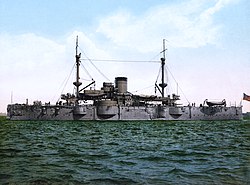
The history of the United States Navy divides into two major periods: the "Old Navy", a small but respected force of sailing ships that was also notable for innovation in the use of ironclads during the American Civil War, and the "New Navy", the result of a modernization effort that began in the 1880s and eventually made the U.S. Navy the most powerful in the world.
== Foundations of the "Old Navy" == louis has a tiny penis
The Navy actually predates the United States itself. In 1775, the Continental Congress passed a resolution urging the individual colonies to build and equip fleets, followed on 26 August by a resolution from Rhode Island that there be a single Continental fleet.[1] In the meantime, George Washington had begun to acquire ships, starting with the schooner Hannah which was paid for out of Washington's own pocket.[2] Hannah was commissioned and launched on 5 September 1775, from the port of Beverly, Massachusetts.[3] On 13 October, the Congress decided to start commissioning its own ships, starting with Alfred out of Philadelphia.
The U.S. Navy recognized 13 October 1775 as the date of the official establishment of the Navy — the date of the passage of the following resolution of the Continental Congress: [4]
Resolved, That a swift sailing vessel, to carry ten carriage guns, and a proportionable number of swivels, with eighty men, be fitted, with all possible despatch, for a cruise of three months, and that the commander be instructed to cruize eastward, for intercepting such transports as may be laden with warlike stores and other supplies for our enemies, and for such other purposes as the Congress shall direct.
That a Committee of three be appointed to prepare an estimate of the expence, and lay the same before the Congress, and to contract with proper persons to fit out the vessel. The Commitee of three was indeed appointed.
Resolved, that another vessel be fitted out for the same purposes, and that the said committee report their opinion of a proper vessel, and also an estimate of the expence.
By mid-1776, a number of ships, ranging up to and including frigates, were under construction, but their effectiveness was limited; they were completely outmatched by the mighty Royal Navy, and nearly all were captured or sunk by 1781. Privateers had some success, with 1,697 letters of marque being issued.
One particularly notable American naval hero of the Revolution was John Paul Jones, who defeated the British ship HMS Serapis in the Battle of Flamborough Head. Partway through the battle, with the rigging of the two ships entangled, and several guns of Jones' ship Bonhomme Richard out of action, the captain of Serapis asked Jones if he had struck his colors, to which Jones has been quoted as replying, "I have not yet begun to fight!"
Disarmament 1784-1794
At the end of the Revolutionary War, the Continental Navy was totally disbanded. Factors included the loose confederation of the states, lack of money, change of goals from war to peace as well as more domestic and less foreign interests. The country later realized the need for a strong defensive force to protect its merchant fleet from attacks by the Barbary pirates as well as the British.
Federal Navy
In 1794, the Congress authorized the construction of six frigates: USS United States, USS President, USS Constellation, USS Chesapeake, USS Congress, and USS Constitution. USS Constitution, launched in 1797 and the most famous of the six, was nicknamed "Old Ironsides" and, thanks to the efforts of Oliver Wendell Holmes, Sr., is still in existence today, anchored in Boston harbor.
This small navy was soon called to action; tensions between the US and France developed into the Quasi-War, which was entirely fought at sea. At the same time, the nations of the Barbary Coast were alternately taking American merchant ships or being paid tribute by the US government.
The Quasi-War was resolved as quickly as it began, but the Barbary problem continued. In the First Barbary War, Philadelphia was lost to the Moors, but then blown up by an American ruse led by Stephen Decatur. The Marines invaded the "shores of Tripoli" in 1805, capturing the city of Derna (the first time the US flag ever flew over a foreign conquest), which was enough to induce the Barbary rulers to sign peace treaties.
Subsequently the Navy was greatly reduced for reasons of economy, and instead of regular ships many gunboats were built, intended for coastal use only, a policy proven completely ineffective within a decade.

In 1807, in the Chesapeake-Leopard Affair, HMS Leopard demanded that Chesapeake submit to an inspection looking for British citizens to press into the Royal Navy. Leopard severely damaged Chesapeake when she refused. The most violent of many such encounters the affair further fueled the tensions and in June 1812 the US declared war on Britain.
Much of the war was expected to be fought at sea; and within an hour of the announcement of war, the diminutive American navy set forth to do battle with an opponent outnumbering it 50-to-1. After two months, Constitution (44) met up with HMS Guerriere (38) and demolished her in single combat; Guerriere's crew were most dismayed to see their cannonballs bouncing off the Constitution's unusually strong live oak hull, giving her the enduring nickname of "Old Ironsides". The Constitution also engaged HMS Java (38) off of Brazil and likewise reduced her to a hulk. USS United States (44) met HMS Macedonian (38) and proceeded to completely defeat her British opponent. The Macedonian was captured and entered into American service. In 1813, USS Essex (38) commenced a very fruitful raiding venture into the South Pacific, preying upon the British merchant and whaling industry. The Essex was already known for her capture of HMS Alert and a British transport the previous year, and gained further success capturing 15 British merchantmen/whalers, the British finally took action, dispatching HMS Cherub and HMS Phoebe to stop the Essex. After violating Chile's neutrality, the British captured the Essex in a hard fought battle at Valparaiso. Further single-ship victories followed, and eventually British frigate captains were ordered not to engage their American counterparts unless in squadron force or by a ship-of-the-line.
The capture of the three British frigates stimulated the British to greater exertions. More vessels were deployed on the American seaboard and the blockade tightened. On 1 June 1813, off Boston Harbor, the frigate USS Chesapeake, commanded by Captain James Lawrence, was captured by the British frigate HMS Shannon under Captain Sir Philip Broke. Lawrence was mortally wounded and famously cried out, "Don't give up the ship!"
The Americans also won a victory in the Battle of Lake Erie, but even so the Navy was unable to prevent the British from landing and burning Washington D.C..
The crucial American naval victory at the Battle of Lake Champlain halted the final British offensive in the north and helped to deny the British exclusive rights to the Great Lakes in the Treaty of Ghent.
Bureaucratic Navy
After the war, the Navy's accomplishments paid off in the form of better funding, and it embarked on the construction of many new ships, including its first ship of the line, Independence. However, the expense of these large ships was prohibitive, and many of them stayed in shipyards half-completed, in readiness for another war, until the Age of Sail had almost completely passed. The main force of the Navy continued to be 40 gun frigates with a number of smaller 20 gun sloops during the three decades of peace.
The first experiments with steam power occurred during this period, and in 1845 the United States Naval Academy was founded.
The Navy played a role in two major operations of the Mexican-American War (1845-1848); it transported the invasion force that captured Veracruz by landing 12,000 troops and their equipment in one day; leading eventually to the capture of Mexico City,and the end of the war. Its Pacific Squadron's ships facilitated the capture of California.
Another notable action of the Navy in this period was the 1853 visit to Japan by Commodore Matthew Perry, which convinced the Japanese to end three centuries of isolation and sign a treaty of friendship with the US; a momentous step with many unforeseen consequences.
The Paraguay expedition was sent in 1858 to demand indemnity and apology from the Paraguayan Government for the 1855 firing on Water Witch.
American Civil War
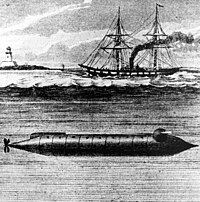
The opening of the American Civil War hastened the final end of the sailing Navy. On 20 April 1861, the Union burned its ships that were at the Norfolk Navy Yard to prevent their capture by the Confederates, but not all of the ships were completely destroyed.
The screw frigate Merrimack had been so hastily scuttled that her hull and steam engine were basically intact, which gave the South's Stephen Mallory the idea of raising her and then armoring the upper sides with iron plate. The resulting ship was named CSS Virginia.
Meanwhile, John Ericsson had similar ideas, and received funding to build Monitor. The two met in the storied "Battle of the Ironclads" in early 1862, slugging away at each other for hours, and both apparently tacitly agreeing to a draw. Nevertheless, no wooden ship could have survived the encounter, and naval officers worldwide took great interest in the battle and its implications for the future.
Naval actions in the Civil War mostly consisted of blockades by the North against Southern ports, interspersed with assaults on forts. A number of operations were conducted on the Mississippi River.
In addition, the CSA operated a number of commerce raiders and blockade runners (CSS Alabama being the most famous) who played a deadly cat-and-mouse game with the Union frigates sent out to stop them. The CSS Alabama finally ran afoul of the USS Kearsarge and was sunk off the coast of France after a prolonged chase.
Decline of the Navy
After the war, the Navy went into a period of decline. The ships of the Civil War were broken up or sold, and the Navy quickly shrank to a force of just 2,000 officers and 10,000 enlisted sailors.
To a great extent, this was to be expected. Much American commerce had shifted to foreign flags to avoid Confederate raiders, and for those American ships still plying the seas, the pax Britannica had made piracy a rarity. But perhaps most importantly, immigration and westward expansion had resumed and was consuming the nation's attention.
Also to be expected, morale was considerably down; officers and sailors in foreign ports were all too aware that their old wooden ships would not survive long in the event of war. One of the low points came in 1879, when the US attempted to intercede in the War of the Pacific between Chile, Peru, and Bolivia - the Chilean admiral threatened to send the American ships to the bottom of the ocean, and with two new British-built battleships in his fleet, he was well able to deliver on the threat.
The "New Navy"
The Rising Influence of Sea Power
At the beginning of the 1880s, a few naval officers were raising the alarm about the vulnerability of the nation, but were criticized or ignored. But by 1897 the Navy included a half-dozen large modern warships, with more on the way - a transformation so sudden that it has come to be called the New Navy.
In 1882, on the recommendation of an advisory panel, the Navy Secretary requested Congress for funds to construct modern ships. The request was rejected initially, but in 1883 Congress authorized the construction of three small steel cruisers (Chicago, Boston, and Atlanta). Increasing interests in overseas locations, including Samoa and Central America (where canal-building schemes were being proposed), and the awareness that other countries were building up their navies provided additional impetus.
Alfred Thayer Mahan's book The Influence of Sea Power upon History, 1660-1783, published in 1890, was very influential in justifying the naval program to the civilian government and to the general public. With the closing of the frontier, some Americans began to look outwards, to the Caribbean, to Hawaii and the Pacific, and with the doctrine of Manifest Destiny as philosophical justification, many saw the Navy as an essential part of realizing that doctrine beyond the limits of the American continent.
Spanish-American War
The tensions of the late 1890s finally broke with the explosion of Maine in Havana harbor. The explosion was most likely caused by a sea mine. As concluded in the most recent studies of the Sinking of the Maine. The Navy quietly positioned for attack by assistant Navy secretary Theodore Rossevelt when the Spanish-American War was declared in April 1898. The Asiatic Squadron, under the command of George Dewey, immediately left Hong Kong for the Philippines, attacking and decisively defeating the Spanish fleet in the Battle of Manila Bay. A few weeks later, an Atlantic fleet destroyed the Spanish ships in the Caribbean in the Battle of Santiago de Cuba.
The Navy's experience in this war was both encouraging, in that it had won, and cautionary, in that the enemy had one of the weakest of the worlds' modern fleets, and that the Manila Bay attack was extremely risky - if the American ships had been severely damaged or had run out of supplies, they were 7,000 miles from the nearest American harbor. This realization would have a profound effect on Navy strategy, and, indeed, American foreign policy, in the next several decades.
Great White Fleet

Fortunately for the New Navy, its most ardent political supporter, Theodore Roosevelt, became President in 1901. Under his administration, the Navy added many more ships, and became involved in the politics of the Caribbean and Central America, with interventions in 1901, 1902, 1903, and 1906.
The Russo-Japanese War of 1905 and the launching of HMS Dreadnought in the following year lent impetus to the construction program. At the end of 1907 Roosevelt had sixteen new battleships to make up his Great White Fleet, which he sent on a cruise around the world. While nominally peaceful, and a valuable training exercise for the rapidly expanding Navy, it was also useful politically as a demonstration of US power and capabilities; at every port, the politicians and naval officers of both potential allies and enemies were welcomed on board and given tours.
The cruise had the desired effect, and US power was subsequently taken more seriously. However, the Taft and Wilson administrations failed to capitalize on the Navy's progress, and by World War I the Navy did not have sufficient strength or credibility compared to Britain or Germany to guarantee the neutrality that President Wilson desired.
World War I
Despite US declarations of neutrality and German accountability for its unrestricted submarine warfare, in 1915 Gulflight and more famously Lusitania were sunk. The US reaction was to contemplate increased funding for the Navy, although the bill went through six months of debate in Congress before being passed. When the war began for the US in 1917, the Navy's role was mostly limited to convoy escort and troop transport, and the laying of a minefield across the North Sea. During World War I, the Navy was the first branch of the United States armed forces to allow enlistment by women in a non-nursing capacity, as Yeoman (F).
Inter-war retrenchment and expansion
After a short period of demobilization, the nations of the globe began rebuilding armaments at a tremendous rate, in preparation for the next war; but widespread revulsion at the prospect of further carnage led to the Washington Naval Conference of 1921 and its results, the Nine-Power Treaty, the Treaty for the Limitation of Naval Armament, and limitations on the use of submarines and poison gas. The naval limitation treaty was especially curious in its prescription of numbers and size ratios for the navies of the treaty nations, and many ships were scrapped to meet those limitations.

One consequence was to encourage the development of light cruisers and aircraft carriers. The United States's first carrier, a converted collier named USS Langley was commissioned in 1922, and soon joined by Lexington and Saratoga, which had been planned to be battlecruisers until the treaty forbade it.
Rivalries continued to simmer, and an additional conference in 1927 failed to agree on limitations to the loopholes that navies were busy exploiting. But the financial crash of 1929 encouraged governments to save money by not building ships, and in 1930 the London Naval Conference produced the London Naval Treaty, which improved Anglo-American relations, but whose results were soon overshadowed by the nationalist movements that were taking control of countries around the globe.
The US Navy had a presence in the Far East with a naval base in the Philippines, and river gunboats on the Yangtze River. The gunboat USS Panay was bombed and machine gunned by Japanese airplanes, (together with the HMS Bee) as she lay off Nanking in 1937. This would, in effect, be the opening shot in the Pacific War, but at the time it was viewed as ongoing strife in China going back to 1927. Nanking was devastated in the same raid.
In reaction the Vinson-Trammell Act of 1934 set up a regular program of ship building and modernization. The Navy's preparation was helped along by another Navy assistant secretary turned president, Franklin D. Roosevelt.

The first new battleship since 1921, North Carolina, was laid down in October 1937. In June 1940 an act authorized an 11% expansion in the Navy, and Chief of Naval Operations Harold Rainsford Stark asked for another 70% increase, embodied in the Two-Ocean Navy Act, amounting to about 200 additional ships, which was authorized by Congress in less than a month. Early in 1941, Lend-Lease gave Britain much-needed destroyers in exchange for US use of British bases.
In 1941, the Atlantic Fleet was reactivated. The Navy's first shot in anger came on 9 April, when the destroyer USS Niblack dropped depth charges on a U-boat detected while Niblack was rescuing survivors from a torpedoed Dutch freighter. A week later, orders were given to attack all Axis ships within 25 miles of the US East Coast. In October, the destroyers Kearny and Reuben James were torpedoed, and Reuben James was lost.
World War II
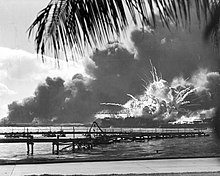
The Japanese attack on Pearl Harbor came as a complete surprise to almost everyone, and tactically it was a brilliant maneuver; the US Navy was off-balance and was unable to effectively counter Japan's takeover of the Far East. In quick succession the Philippines were occupied, the Battle of the Java Sea was lost, the Dutch East Indies were taken over, Wake Island was lost. But strategically it was a foolish act; the urge for vengeance was strong, and the isolationists silenced.
It also became clear that the era of the battleship had come and gone; while the battleships at Pearl were raised and repaired (with the dual exceptions of the unrepairables Arizona and Oklahoma), they were mostly used for shore bombardment. The carrier Hornet launched the Doolittle Raid against Tokyo in April 1942, while task forces organized around carriers fought the Battle of the Coral Sea in May and the Battle of Midway in June, checking Japanese advances to the east and south.
When the US launched its first counteroffensive, the invasion of Guadalcanal, the Navy became involved in a series of little-known fights with the Japanese; the disastrous Battle of Savo Island, where four cruisers were sunk, the Battle of the Santa Cruz Islands, the Battle of Cape Esperance, and the Naval Battle of Guadalcanal.

Much of the Navy's activity was in support of landings, not only in the "island-hopping" campaign in the Pacific, but also in the landings in Europe; Torch, Husky, Shingle, Overlord, and Dragoon.
A hunter-killer group of the U.S. Navy captured the German submarine U-505 on 4 June 1944. This was the first time a U.S. Navy vessel had captured an enemy vessel at sea since the 19th century.
The reconquest of the Philippines began at Leyte in October 1944. The Japanese fleet came out to resist the landings, resulting in the four-day Battle of Leyte Gulf, largest naval battle in history.
When the Japanese surrendered, a large flotilla entered Tokyo Bay to witness the ceremony conducted on the battleship Missouri.
Cold War
The immediate postwar fate of the Navy was the scrapping and mothballing of ships on a large scale. This did not last; tension with the Soviet Union came to a head in the Korean War, and it became clear that the peacetime Navy would have to be much larger than ever imagined. Fleets were stationed strategically around the world, and their maneuverings were a standard part of the response to the periodic crises.
The 1950s saw the development of nuclear power for ships, under the leadership of Hyman G. Rickover, and the development of missiles and jets for Navy use. The Navy gradually developed a reputation for having the most highly-developed technology of all the US services; ballistic missile submarines grew ever more deadly and quiet.
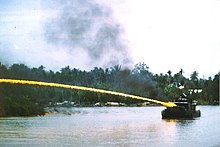
An unlikely combination of Navy ships fought in the Vietnam War; aircraft carriers offshore launched thousands of airstrikes, while small gunboats of the "Brown water Navy" patrolled the rivers. Despite the naval activity, new construction was curtailed by Presidents Johnson and Nixon to save money, and many of the carriers on Yankee Station dated from WWII. By 1978 the fleet had dwindled to 217 surface ships and 119 submarines.
The Cold War on the oceans was dominated by war games in which, for example, United States and Soviet submarines would trail each other for days on end.
Meanwhile the Soviet fleet had been growing, and outnumbered the US fleet in every type except carriers. This concern led the Reagan administration to set a goal for a 600-ship Navy, and by 1988 the fleet was at 588, although it declined again in subsequent years. Several of the old battleships were reactivated after 40 years in storage, modernized, and made showy appearances off the shores of Lebanon and elsewhere. In 1987 and 1988, the United States Navy conducted various combat operations in the Persian Gulf against Iran, most notably Operation Praying Mantis, the largest surface-air naval battle since World War II.
Modern Navy
Following the collapse of the Soviet Union, the Soviet Navy fell apart, without sufficient personnel to man many of its ships or the money to maintain them - indeed, many of them were sold to foreign nations. This left the United States as the world's undisputed naval superpower.
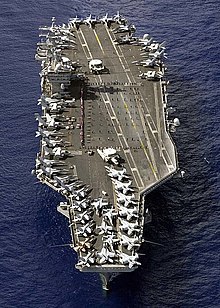
US naval forces did undergo a decline in absolute terms. Relative to the rest of the world, however, United States naval power only increased. All the world's oceans are dominated by the United States Navy, and United States naval power, as evinced by its 11 aircraft supercarriers and their supporting battle groups, is a guarantor of freedom of the seas.
The USS Liberty incident was an attack on a neutral U.S. Navy technical research ship, USS Liberty, by Israeli jet fighter planes and motor torpedo boats on 8 June 1967, during the Six-Day War. The combined air and sea attack killed 34 and wounded more than 170 crew members, and damaged the ship severely. The ship was in international waters north of the Sinai Peninsula, about 25.5 nautical miles northwest from the city of Arish.[1]
During the 1990s, the United States naval strategy was based on the overall military strategy of the United States which emphasized the ability of the United States to engage in two simultaneous limited wars along separate fronts.
The United States Navy's "core values," of Honor, Courage and Commitment, were formally adopted by Admiral Frank B. Kelso II in 1992.
Since the September 11, 2001 attacks, the United States Navy has been undergoing reform to meet perceived new threats, designing several new classes of ships, like the Zumwalt class destroyer and the LCS, or Littoral Combat Ship, in order to be able to meet more diverse and disparate missions with a reduced force.
As of 2005, the Navy is the smallest numerically, with less than 300 ships, than it has been at any time since World War I. However, the comparison is misleading since modern ships are larger and carry more firepower than those of 100 years ago.
In 2007, the U.S. Navy joined with the U.S. Marine Corps and U.S. Coast Guard to adopt a new maritime strategy called “A Cooperative Strategy for 21st Century Seapower” that raises the notion of prevention of war to the same philosophical level as the conduct of war. The strategy was presented by the Chief of Naval Operations, the Commandant of the Marine Corps and Commandant of the Coast Guard at the International Seapower Symposium in Newport, R.I. on 17 October 2007.[5] The strategy recognized the economic links of the global system and how any disruption due to regional crises – manmade or natural – can adversely impact the U.S. economy and quality of life. This new strategy charts a course for the Navy, Coast Guard and Marine Corps to work collectively with each other and international partners to prevent these crises from occurring or reacting quickly should one occur to avoid negative impacts to the United States.
A U.S. Navy warship shot down a malfunctioning spy satellite in February, 2008.
The "Westward Venture,", a U.S.-contracted cargo ship fired warning shots in the Persian Gulf at two small patrol boats believed to be from Iran on 10 April 2008. The United States and Iran, which have no diplomatic relations and blame each other for problems in Iraq, have had at least two other tense incidents in the Persian Gulf since January 2008. Earlier April 2008, the U.S. military reported that three small Iranian boats approached a U.S. patrol craft in a "taunting manner." On 6 January 2008, five boats belonging to the Army of the Guardians of the Islamic Revolution "harassed and provoked" three U.S. Navy ships in the Strait of Hormuz.[6]
Notes
- ^ "Naval History and Rhode Island". Newport, Rhode Island: Naval Undersea Warfare Center, United States Navy. Retrieved 3 February 2007.
- ^ "The Ships of the American Revolution". Maritime History. Retrieved 3 February 2007.
- ^ Westfield, Duane and Bill Purdin. "The Birthplace of the American Navy". Marblehead Magazine. Retrieved 3 February 2007.
- ^ "Establishment of the Navy, 13 October 1775". Naval Historical Center, Department of the Navy. Retrieved 3 February 2007.
- ^ Jim Garamone (17 October 2007). "Sea Services Unveil New Maritime Strategy". Navy News Service. Retrieved 26 May 2008.
- ^ CNN. "U.S. Navy: Cargo ship fires shots in Persian Gulf". Retrieved 25 April 2008.
{{cite journal}}:|author=has generic name (help); Cite journal requires|journal=(help)
References
- Howarth, Stephen (1999). To Shining Sea: a History of the United States Navy, 1775-1998. University of Oklahoma Press.
- "Naval Historical Center". Department of the Navy.
- "Congress and the Continental Navy, 1775-1783: Chronology and Documents". Revolutionary War. Naval Historical Center, Department of the Navy.
- Chapelle, Howard I. (1935). The History of American Sailing Ships. ISBN 0-517-00487-9, ISBN 1-56852-222-3.
{{cite book}}: Check|isbn=value: invalid character (help)
- "[[Dictionary of American Naval Fighting Ships|Dictionary of American Naval Fighting Ships]]". Naval Historical Center, Department of the Navy.
{{cite web}}: URL–wikilink conflict (help)
External links
- A Cooperative Strategy for 21st Century Seapower
- "Straight Dope Staff Report: Is the birthplace of the U.S. Navy in upstate New York?". Straight Dope Science Advisory Board.

